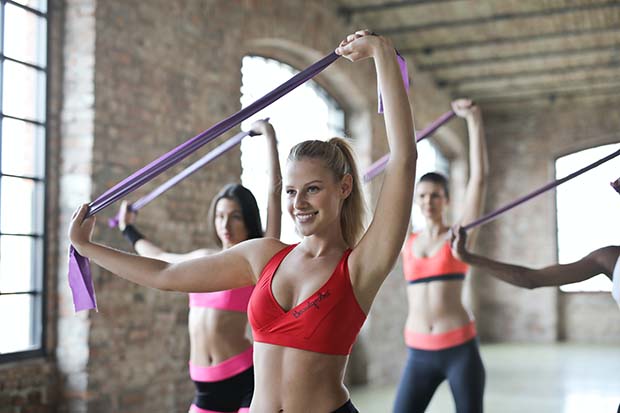How To Minimize The Risk Of Step Aerobics Injuries

Step aerobics is a low-impact form of exercise. This means that at least one foot is on the ground or step at all times. The exercise was, in fact, developed by a fitness instructor to aid in her rehabilitation following a knee injury.
As such, the chances of sustaining injury during step exercise is less than with many other forms of exercise. However, the risk does still exist. Some of the most common types of injury include sprains and muscle strains, tendinitis and meniscus tears.
Table of Contents
ToggleMinimize Injury Risks During Exercise
Regardless of the type of exercise you perform, there are some steps that you should always take to reduce injury risks:
Choose Appropriate Exercise
Choose your preferred exercise according to what you want to achieve, but also what you are capable of. High impact exercise, which includes running and jogging, is not suitable for those with complaints like arthritis.
One of the benefits of step aerobics is that it is a low impact workout which places little stress on the joints. Know your physical limitations and be bound by them.
Get The Right Equipment And Accessories
Whatever form of exercise you take up, make sure that you’re fully prepared. This means buying the right equipment and accessories, and ensuring that you have the right workout gear. Comfortable shoes are vital in almost all forms of exercise.
Check our guide on the best aerobics steps to help find the right equipment for your next home workout.
Start Small
Start your new exercise routine slowly and don’t just jump straight into the most difficult program.
Whether you are changing from one form of exercise to another, or you are introducing regular exercise to your daily life for the first time, starting at too difficult a level is not only likely to deter you from continuing with the exercise but it increases the likelihood of suffering a muscle or joint injury.
If you’re using an exercise bike, start with minimal resistance and build up. If you’re taking your first steps into step aerobics, start on a 4” step or with no elevation at all.
Always Warm Up
Warm up is vital to the body. Cold muscles are much more prone to injury, and jumping straight into your first set means that you could do yourself a long-term injury straight away.
Warming up relaxes, stretches, and warms the muscles up. Walk or do dynamic stretches for five to ten minutes before you start your daily routine.
Check Your Technique
Good technique and proper form will also minimize the risk of injury. Arching your back, landing incorrectly, or using the wrong part of your body when lifting, are all common causes of exercise injury.
Watch videos, speak to a personal trainer, and follow instructions to ensure that your body is in the right positions and that you move correctly.
Hydrate
With any kind of exercise regimen, you will sweat. This means that your body is losing essential fluids and the only way to replace them is by rehydrating your body.
There are plenty of drinks and rehydration powders on the market that claim to rehydrate the body effectively, but water remains one of the most efficient methods of rehydration. Make sure you break approximately every 15 minutes to take a few sips of water.
Cool Down
Avoid the temptation to flop onto the sofa when your one hour of exercise is up. Cooling down relaxes the muscles after any kind of workout. It will reduce the stiffness that you feel next day.
Cooling down also gradually reduces heart rate and breathing rates. It enables the muscles to return to their optimal length and position. It can even stop the feeling of dizziness by preventing blood from pooling in the lower body.
Eliminate Step Aerobics Injuries
There are also some specific step aerobics guidelines to follow, that will help reduce the risk of injury.
Step Height
The height of the step bench determines how challenging a routine is. The higher the bench, the greater the effort required to step up and down. A higher bench also means greater stretching, which can prove beneficial during controlled routines.
However, increasing bench height not only increases difficulty but also injury risk. Your knee should not progress past your toes as you step up, otherwise you need to reduce step height.
A higher step means that you over extend the patella in your knee, and doing this too often can lead to long-term knee injury. Stepping too far down also means that you over extend your toes and place unnecessary pressure on the balls of your feet.
Most classes recommend starting with a 4” step height, although beginners can start with no step at all. The height can be increased to 6” or 8”, and some professional classes use 10” steps.
Balance
Check where you place your feet on the step. Ensure that your feet are near the middle of the step and that all of your foot is placed firmly on the surface. If you stand on a corner or edge, there is a good chance of falling.
Even if you manage to steady yourself, you increase the chance of twisting or spraining your ankle. Take it slowly at first and ensure that you step all the way onto the stepper. Once you have mastered foot placement, you can increase the tempo gradually over time.
Foot Placement On The Bench
As well as the danger of falling off the step, there are long-term injuries that can be caused by bad form. If you only place the front of your foot on the step and your heel hangs over, this means that the heel is lower than the rest of the foot. Doing this repeatedly can lead to Achilles tendinitis.
Step Distance
Proper foot placement is important when stepping off the stool too. You should be stepping about a foot away from the base of the aerobics step.
Stepping further away than this means that your body will naturally lean forward, placing too much pressure on the ankle. Stepping too close means that you are more likely to catch the step when you step back onto the board, which can cause you to fall and injure yourself.
Floor Pounding
It’s very easy to get carried away when exercising, and especially when you’re in the zone. Take care not to translate this enthusiasm into floor pounding.
You should land comfortably on your foot, and don’t stomp. Stomping places pressure on the bones of your feet. Step aerobics is a low impact form of exercise, so adopt a more subtle landing.
Vary Your Exercise Routines
Although step aerobics is a low impact exercise, it does still place pressure on the knees. This is especially true if you perform the exercise for extended periods or you perform step aerobics too often. Change your routine up and look for other beneficial forms of aerobic exercise.
Sticking to the same routine day in, day out, isn’t the best way to exercise anyway. Your body becomes accustomed to the movements and the pressure, and every time you repeat a routine, your muscles learn.
Keep your muscles on their toes by changing from step aerobics to an exercise bike or other form of intense workout, and come back to step in a few days.
Don’t Attempt Too-Difficult Routines
Step aerobics can appear simple, at first glance. After all, we all take multiple steps every day and most of us can climb a flight of stairs with relative ease. But, don’t be fooled. Step aerobics can be a very intense workout and some of the advanced routines are too much for a novice.
Start out with a basic class and move up once you have mastered these routines. This can be especially important when working out at home – at a step class, your instructor will notice if you’re pushing it too hard or attempting routines that are too advanced for you. At home, you don’t have the luxury of somebody spotting you.
Performing Step Aerobics Safely
Step aerobics is an intense and effective form of aerobic exercise. It gets the blood pumping and exercises the lungs. It is also great for strengthening leg and core muscles. However, as with any form of exercise, there is the potential for injury.
Take it easy until you get used to the movements. Ensure that you adopt the right form and posture, and mix step with other forms of exercise to prevent undue strain on the knees.
Use Resistance Bands
Using resistance bands is an excellent way to injury proof your joints and muscles. Try these glute & leg workout for injury-proofing your lower body. Follow our Instagram and YouTube channels for more workouts.


